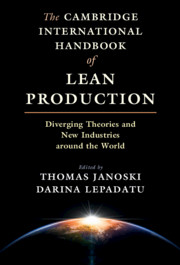 The Cambridge International Handbook of Lean Production
The Cambridge International Handbook of Lean Production Book contents
- The Cambridge International Handbook of Lean Production
- The Cambridge International Handbook of Lean Production
- Copyright page
- Dedication
- Contents
- Tables
- Figures and Sidebars
- Preface
- Acknowledgments
- Contributors
- Abbreviations
- 1 Lean Production as the Dominant Division of Labor
- Part I Theories of Lean Production
- Part II Lean Production across Industries
- Part III Lean Production Around the World
- Name Index
- Subject Index
- References
1 - Lean Production as the Dominant Division of Labor
Theories, Industries, and National Contexts
Published online by Cambridge University Press: 11 March 2021
- The Cambridge International Handbook of Lean Production
- The Cambridge International Handbook of Lean Production
- Copyright page
- Dedication
- Contents
- Tables
- Figures and Sidebars
- Preface
- Acknowledgments
- Contributors
- Abbreviations
- 1 Lean Production as the Dominant Division of Labor
- Part I Theories of Lean Production
- Part II Lean Production across Industries
- Part III Lean Production Around the World
- Name Index
- Subject Index
- References
Summary
The Cambridge International Handbook of Lean Production provides an overall argument that lean systems are the dominant division of labor in the world, which are spreading in diverse ways to the service industries and around the world. Whether you think lean is great or not, it is the overwhelming influence on the world-wide division of labor. Further, this Handbook examines the many sides of the lean production debate that rarely interact. One side sees efficiency and quality as paramount, and the other side sees the protection of workers as key. Consequently, this Handbook focuses on three major parts:The result is an international Handbook that is a comprehensive interdisciplinary examination of the future of the world of work and management in our global economy.
- Type
- Chapter
- Information
- The Cambridge International Handbook of Lean ProductionDiverging Theories and New Industries around the World, pp. 1 - 32Publisher: Cambridge University PressPrint publication year: 2021
References
- 1
- Cited by


